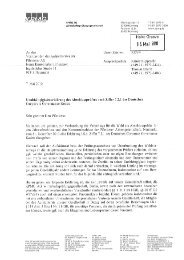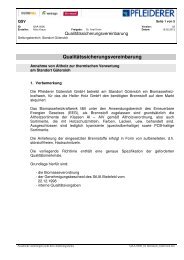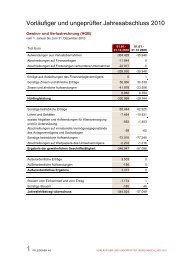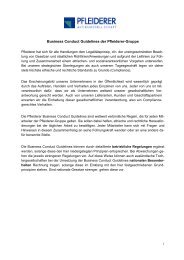PDF, 1.2 MB - Pfleiderer AG
PDF, 1.2 MB - Pfleiderer AG
PDF, 1.2 MB - Pfleiderer AG
You also want an ePaper? Increase the reach of your titles
YUMPU automatically turns print PDFs into web optimized ePapers that Google loves.
116 being focused: being better<br />
8. Deferred taxes<br />
9. Accounting for goodwill<br />
and impairment<br />
10. Discontinued operations<br />
According to HGB, deferred taxes must be calculated on all temporary differences resulting<br />
between the Company’s tax balance sheet and its consolidated balance sheet (timing concept),<br />
thereby applying the current corporate income tax rate. In this procedure, only deferred tax<br />
liabilities must be recognized, while the Company has the option – with certain exceptions – to<br />
capitalize deferred tax assets or not. No deferred taxes may be carried to cover quasi-permanent<br />
differences which are only reversed after a very long period of time, or following sale or<br />
winding up. The same applies to loss carryforwards.<br />
According to US GAAP, SFAS 109, deferred taxes are formed for valuation differences<br />
between the assets and liabilities on the tax balance sheet and those on the consolidated<br />
balance sheet, based on the statutory applicable tax rate at the end of the reporting period<br />
and expected tax rate applicable at the time of reversal. Deferred taxes must be carried for all<br />
temporary differences between tax values and carrying amounts in the consolidated balance<br />
sheet. Using this procedure, quasi-permanent differences are classified as temporary (temporary<br />
concept). This aside, deferred taxes must be formed for tax loss carryforwards. Deferred<br />
tax assets must also be examined at every balance sheet date for realizability and adjusted<br />
through valuation allowances where necessary.<br />
Under German commercial law, acquired goodwill must be capitalized and amortized over its<br />
average useful life. Where it results from purchase accounting, goodwill must be offset against<br />
equity at its full amount in the year of creation. Goodwill must be written down when, for example,<br />
the future earnings position of the company is unlikely to produce positive results. Under<br />
German commercial rules, the extraordinary amortization is considered justifiable in view of<br />
the prudence principle.<br />
Under US GAAP, goodwill is also capitalized, but scheduled amortization is no longer<br />
permitted. Instead, SFAS 142 states that goodwill must be subjected to an impairment test at<br />
least once a year, and its value adjusted where necessary.<br />
Sec. 246 (2) HGB states that expenses and income or assets and liabilities may not be offset<br />
against each other. This has the effect that discontinued operations cannot be shown separately<br />
in the financial statements.<br />
Under the US GAAP rules laid down in SFAS 144, on the other hand, the statement of<br />
income and the balance sheet must be adjusted for effects of discontinued operations. The adjusted<br />
figures must be summarized in a separate position as results in the statement of income<br />
and as assets and liabilities on the balance sheet.

















